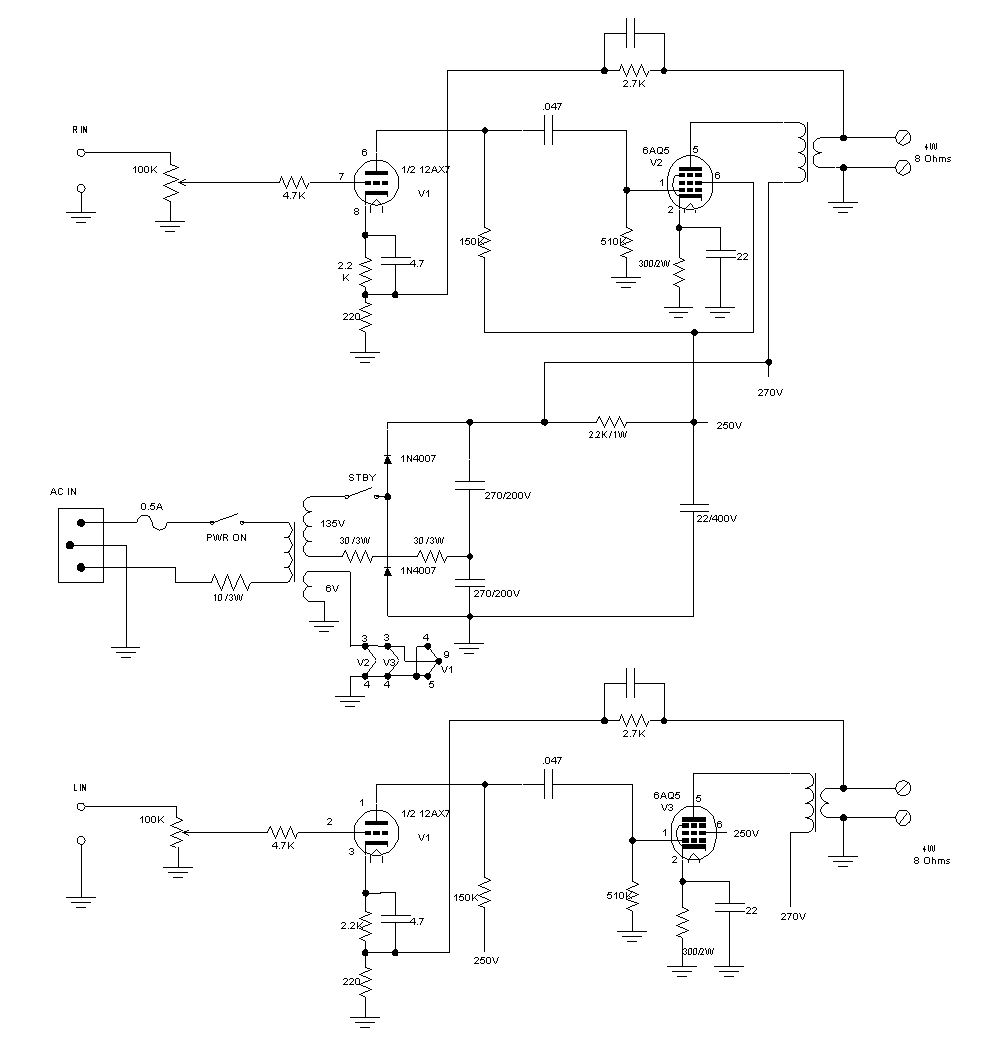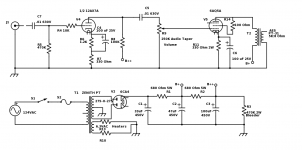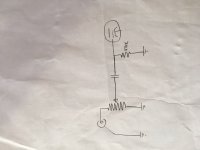It is a fundamental error to insert the volume control inside the feedback loop. It has to go at the input.
The hum is probably 120Hz resulting from insufficient B+ filtering. The original schematic has an extra RC section, which attenuates hum far more than the increased resistance in a single section.
The frequency response problems might get better when control placement is fixed. It depends to some extent on the amount of feedback applied. If performance is still disappointing, then we should evaluate closed-loop squarewave response. Low-end OPTs often need help to work as desired in feedback circuits.
The hum is probably 120Hz resulting from insufficient B+ filtering. The original schematic has an extra RC section, which attenuates hum far more than the increased resistance in a single section.
The frequency response problems might get better when control placement is fixed. It depends to some extent on the amount of feedback applied. If performance is still disappointing, then we should evaluate closed-loop squarewave response. Low-end OPTs often need help to work as desired in feedback circuits.
The hum is probably 120Hz resulting from insufficient B+ filtering. The original schematic has an extra RC section, which attenuates hum far more than the increased resistance in a single section.
Would it be OK if I moved the B+ taps to B++ in my schematic for additional filtering? Or do you think I need an additional RC in my filter stack?
Would it be OK if I moved the B+ taps to B++ in my schematic for additional filtering? Or do you think I need an additional RC in my filter stack?
You can certainly supply the anode and G2 from the same power supply tap, but both voltages end up lower this way, and it's usually G2 that needs maximum ripple reduction.
Simple math shows that two RC sections of 100R and 100uF reduce 120Hz ripple to 1.38%. One section of 680R and 100uF reduces it to 1.92%, with greater voltage loss and worse regulation. Regulation isn't a big issue with most class A amps, though. Use PSUD to dig deeper.
Last edited:
You can certainly supply the anode and G2 from the same power supply tap, but both voltages end up lower this way, and it's usually G2 that needs maximum ripple reduction.
Ah, OK, then perhaps just move G2 to B++. I will experiment. Thanks!
When the amplifier is in pentode mode you want a fair amount of feedback to keep the output impedance at a reasonable level. That requires all the open loop gain you can get. But by placing the volume pot inside the feedback you get a low open loop gain (zero when volume pot is turned down) and therefore the output impedance is probably unacceptable. The cure, sorry to say, is to move the volume pot to the input of the amplifier. I know you had some issues that way (extreme noise when turning the pot) but those issues must be solved without creating new ones.
When the volume pot was at the front, did you try different sources? did you try it without any source connected? Did you try to short the input to see if the problem persisted? Did you try an input cap? Those are things I would try.
Perhaps you could post a schematic of your original circuit and I am sure some forum members will give you suggestions about what to try. Do not expect any input from me. I am not experienced myself – I have not built anything the last 25 years.
Good luck,
Torben
When the volume pot was at the front, did you try different sources? did you try it without any source connected? Did you try to short the input to see if the problem persisted? Did you try an input cap? Those are things I would try.
Perhaps you could post a schematic of your original circuit and I am sure some forum members will give you suggestions about what to try. Do not expect any input from me. I am not experienced myself – I have not built anything the last 25 years.
Good luck,
Torben
When the volume pot was at the front, did you try different sources?
Yes, as previously stated. I used multiple different brands of CD player, different music. I used a stand-lone preamp and a high-quality turntable with a high-qualify MM cartridge. I tried a tape deck.
I tried different speakers as well.
did you try it without any source connected?
No, I did not think to do that.
Did you try to short the input to see if the problem persisted? Did you try an input cap? Those are things I would try.
I used an input cap. I tested the unit without a volume control and didn't like the way it sounded. Obviously no volume pot scratchiness, but it still sounded very inferior, loads of distortion. Once I cut the hole in the chassis for the volume control though, I was pretty much stuck with it.
Perhaps you could post a schematic of your original circuit and I am sure some forum members will give you suggestions about what to try. Do not expect any input from me. I am not experienced myself – I have not built anything the last 25 years.
Good luck,
Torben
I built the amp initially using this schematic:

This is, I believe, a design by Tom Bavis, whom I have much respect for. I built the circuit as shown, not including the power section, since I used a tube rectifier. Voltages, however, were the same.
I used a 100K pot as shown in the schematic. It sounded like ***. Every time I moved the pot, the scratching noises were horrible. At low volume, it sounded fine. At top volume, it was not terrible. Everywhere in between, bad, bad, bad.
And yes, to repeat once again, I tried a variety of pots, including a rather expensive Alps, which sounded precisely as bad that the cheap one that it replaced.
Then I took it apart and rebuilt it using this schematic:
An externally hosted image should be here but it was not working when we last tested it.
It sounded exactly the same - bad. To be honest, I did not use a 500K pot, though, I kept using a 100K pot, because I did not have a 500K pot at that time (I have ordered one and am expecting it shortly).
Then I took it apart again and rebuilt it using this schematic:
An externally hosted image should be here but it was not working when we last tested it.
Same problem.
I have tried to work through the issue on my own. I have rebuilt this so many times i want to throw it into traffic just to enjoy seeing it run over by a truck.
I've built more than a few amplifiers, even though I am a newbie. I have never had these kinds of problems before. I have searched Google to the best of my ability, and those who have had these kinds of 'scratchy' issues with the volume pot never seem to find a resolution - it's just one of those mysteries of life or something.
So I tried very hard to solve this on my own. When I found the 4S Universal Preamp schematic, I tried it and it worked.
Of course, now that I am down to just a couple minor problems and have a very quiet volume control, everyone tells me I am the wrongest wrongy thing since wrong was invented.
So I'm a tad frustrated. To be honest, I don't have a lot of interest in putting the volume pot back in front. Been there, done that, it doesn't work, and I don't know why. It DOES work where I am not supposed to put it. No idea why, and running out of concern. I really just want to clean up the few remaining issues, rather than arguing endlessly about how wrong I am to do it this way.
Not that I don't appreciate the assistance. As I said, I am a newbie, I know that there is a ton I do not know. I'm trying really hard to comply with all of your requests, but I've done all the stuff you guys suggested - doesn't work. I'm past that now.
The very first preamp I built (early eighties) suffered from noise when turning the volume pot. The problem disappeared when I inserted a large value resistor between the pot viper and ground. I inserted that resistor (1M if I remember correctly) to make sure there was a stable connection between ground and the grid of the next tube. I never left that praxis until I got married (sigh) and stopped building anything. I understand that you have tried high quality volume pots and I suppose that ought to rule out that cure (the extra resistor).
Last edited:
It's best to relax and view these problems as an interesting puzzle instead of a personal assault. There has to be a sensible explanation for the noisy input level control. The most common cause is DC current flowing through the control, perhaps grid leakage current caused by a gassy tube. Did you ever check for DC bias on the control element? It wouldn't take much. Other ways this could happen are spurious oscillation and rectification of RF from a nearby broadcast transmitter, cell tower, etc. A grid stopper resistor of 10K located at zero distance from the 12AX7 grid pin is generally sufficient to prevent spurious oscillation. RF interference (RFI) can be a bigger problem, depending on frequency, but it's still manageable. A scope would be helpful...
Same comment as above. The reason for noisy pots is simple; there's DC on the pot, and it shouldn't be there (design error). Tubes need a DC path between the grid and ground to prevent the bias from wandering around, and a pot is not the right solution. Simple fix: a 100K resistor from grid to ground, leaving the input pot as-is. There's no need for a DC-blocking cap on the input pot. If the pot is 50 years old, throw it out and replace with a modern low-noise part.
As mentioned earlier, a pot should never be inside a feedback circuit. First, it won't work, since the feedback will counteract the change in forward gain (that's kind of the point with feedback), secondly, it risks instability issues with motorboating and HF oscillation, which are Bad Things.
As mentioned earlier, a pot should never be inside a feedback circuit. First, it won't work, since the feedback will counteract the change in forward gain (that's kind of the point with feedback), secondly, it risks instability issues with motorboating and HF oscillation, which are Bad Things.
Last edited:
Thanks to everyone with all the help!
I understand that putting the volume control in the feedback loop is bad. However, no matter what I tried (and I tried ALL of your suggestions, one at a time), the pot in front of the 12AX7 was not working. I used the very best Alps pot I could afford, it sounded just as horrible as the cheapest Parts Express pot.
So, sorry, I'm not doing it that way.
To remove the problem of the volume control being in the feedback loop, I had to do one of two things. Either dump the volume control, or dump the feedback loop. I could not dump the volume control - already cut the hole in the chassis for the thing.
So I triode-strapped the 6AQ5A tubes and dropped the feedback loop entirely. Lost some gain, but now I am not in violation of the 'volume control in the feedback loop' rule.
Here is the final schematic. I am boxing it up today, it will be shipped to my friend tomorrow.
Not perfect, but the best I can do.
Thanks again for everyone's advice. I wish the volume control thing had worked the way you seem to think it would. All I can say is it doesn't. Don't know why.
I understand that putting the volume control in the feedback loop is bad. However, no matter what I tried (and I tried ALL of your suggestions, one at a time), the pot in front of the 12AX7 was not working. I used the very best Alps pot I could afford, it sounded just as horrible as the cheapest Parts Express pot.
So, sorry, I'm not doing it that way.
To remove the problem of the volume control being in the feedback loop, I had to do one of two things. Either dump the volume control, or dump the feedback loop. I could not dump the volume control - already cut the hole in the chassis for the thing.
So I triode-strapped the 6AQ5A tubes and dropped the feedback loop entirely. Lost some gain, but now I am not in violation of the 'volume control in the feedback loop' rule.
Here is the final schematic. I am boxing it up today, it will be shipped to my friend tomorrow.
Not perfect, but the best I can do.
Thanks again for everyone's advice. I wish the volume control thing had worked the way you seem to think it would. All I can say is it doesn't. Don't know why.
Attachments
I tried ALL of your suggestions, one at a time
I wish the volume control thing had worked the way you seem to think it would. All I can say is it doesn't. Don't know why.
Because you didn't wire it up this way. You always had DC on the pot.
Attachments
Because you didn't wire it up this way. You always had DC on the pot.
I did wire it up that way as well. Sorry, but I did.
One other thing I didn't see mentioned specifically on this thread is that the pot housing itself needs to be well grounded to the circuit ground, AND the chassis also grounded at one point to audio circuit ground.
I have had scratchy pot movement using the same pot type (Alps blue velvet) when the pot housing was not grounded. On the Alps Blue Velvet, it's the metal piece on the front of the pot where the shaft extends from that needs to be grounded. Not that this is your issue, but it's something to look at.
I have had scratchy pot movement using the same pot type (Alps blue velvet) when the pot housing was not grounded. On the Alps Blue Velvet, it's the metal piece on the front of the pot where the shaft extends from that needs to be grounded. Not that this is your issue, but it's something to look at.
Last edited:
One other thing I didn't see mentioned specifically on this thread is that the pot housing itself needs to be well grounded to the circuit ground, and the chassis also grounded at one point to audio circuit ground.
I have had scratchy pot movement using the same pot type (Alps blue velvet) when the pot housing was not grounded. On the Alps Blue Velvet, it's the metal piece on the front of the pot where the shaft extends from that needs to be grounded. Not that this is your issue, but it's something to look at.
I grounded the pot to the circuit ground and the circuit ground is chassis grounded. I experimented with lifting the circuit ground from the chassis, but it seemed to make no difference. I also experimented with grounding the pot to the chassis but not the circuit ground - no difference there either.
In any case, the amp was shipped out in today's mail. In a couple days it will be in Kansas. I most likely won't see it again, so it's on to the next project.
Also, forgot to mention to everyone, but the issue I was having with highs and lows not sounding right was fixed when I replaced the original .47 uF coupling capacitor with a .01 uF. Now it sounds clear as a bell, good bass, highs are no longer shrill, midrange is smooth. I'm actually pretty pleased with the final design. Shame to give up so much gain to avoid doing GNF, but the triode strapped tubes sound pretty darned good.
Wig, did you ever confirm that DC bias at the control element was no more than a mV or two -- and when making this confirmation, that the control was still noisy? I ask this because voltmeters can sometimes kill a parasitic oscillation when probe contact is made.
I am embarrassed to say I don't know how to do that. For future projects, could you explain the process?
- Status
- This old topic is closed. If you want to reopen this topic, contact a moderator using the "Report Post" button.
- Home
- Amplifiers
- Tubes / Valves
- Request review of my schematic

